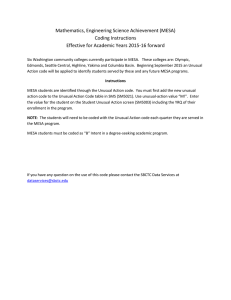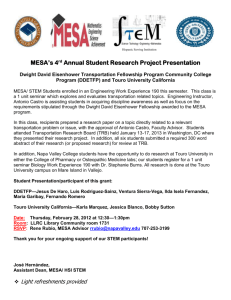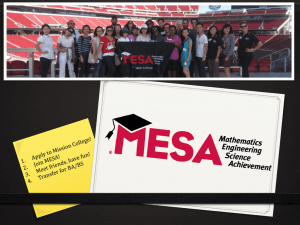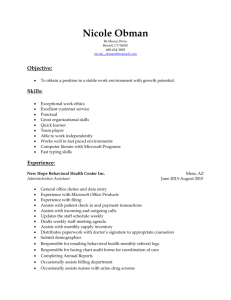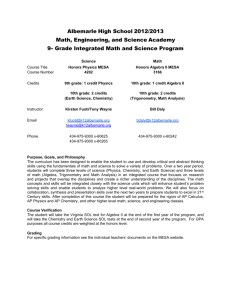business backgrounder
advertisement
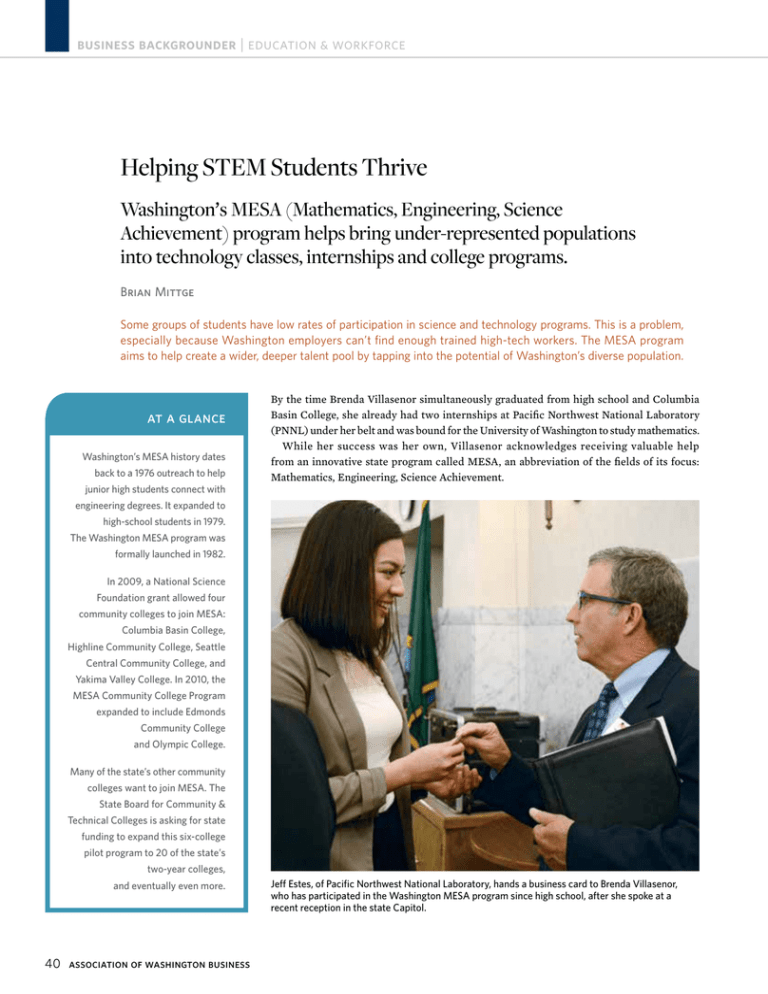
business backgrounder | education & workforce Helping STEM Students Thrive Washington’s MESA (Mathematics, Engineering, Science Achievement) program helps bring under-represented populations into technology classes, internships and college programs. Brian Mittge Some groups of students have low rates of participation in science and technology programs. This is a problem, especially because Washington employers can’t find enough trained high-tech workers. The MESA program aims to help create a wider, deeper talent pool by tapping into the potential of Washington’s diverse population. at a glance Washington’s MESA history dates back to a 1976 outreach to help junior high students connect with By the time Brenda Villasenor simultaneously graduated from high school and Columbia Basin College, she already had two internships at Pacific Northwest National Laboratory (PNNL) under her belt and was bound for the University of Washington to study mathematics. While her success was her own, Villasenor acknowledges receiving valuable help from an innovative state program called MESA, an abbreviation of the fields of its focus: Mathematics, Engineering, Science Achievement. engineering degrees. It expanded to high-school students in 1979. The Washington MESA program was formally launched in 1982. In 2009, a National Science Foundation grant allowed four community colleges to join MESA: Columbia Basin College, Highline Community College, Seattle Central Community College, and Yakima Valley College. In 2010, the MESA Community College Program expanded to include Edmonds Community College and Olympic College. Many of the state’s other community colleges want to join MESA. The State Board for Community & Technical Colleges is asking for state funding to expand this six-college pilot program to 20 of the state’s two-year colleges, and eventually even more. 40 association of washington business Jeff Estes, of Pacific Northwest National Laboratory, hands a business card to Brenda Villasenor, who has participated in the Washington MESA program since high school, after she spoke at a recent reception in the state Capitol. business backgrounder | education & workforce Washington MESA helps build pathways to college and careers in science, technology, engineering and math, the so-called STEM fields that power an increasing share of the modern economy. The program works to help women and underrepresented minorities succeed in science and technology studies. From after-school clubs to a freshman robotics program, mentoring to study groups, MESA was a big help, said Villasenor, the first person in her extended family to attend college. “I remember how my parents heavily enforced education. It was the only way to ensure a successful future,” she said. “I can confidently say my educational goals would not have been achieved without MESA.” Her success is being duplicated in public schools, two-year colleges and universities across the state, helping increase the graduation rate of students and expanding the state’s pool of STEM workers with a diverse, energetic population. It’s a crucial need. Washington, home of tech giants such as Microsoft and Boeing, as well as a Department of Energy national laboratory, isn’t keeping up with the need for high-tech workers. The state has 25,000 technology jobs going unfilled for lack of trained people to fill them. filling the skills gap The MESA advisory board includes representatives from employers such as Boeing and PNNL. Board member Jeff Estes is a fixture in MESA and other programs to encourage teenagers to pursue STEM. To help create a pipeline of skilled workers, PNNL hosts 800 to 1,100 interns a year through a variety of programs for students as young as high school to those in post-graduate studies, said Estes, a Battelle employee who has worked at PNNL since 1998. Battelle’s goal, he said, is to prepare the next generation of scientists, engineers and innovators. The company pursues that goal in many ways, and was a founding member of MESA more than three decades ago. PNNL has been on the board ever since. Helping bring underrepresented populations into STEM is enlightened self-interest, Estes said. “Diversity is a powerful thing that drives success,” he said. “When you have complex problems, you benefit from a variety of experiences and points of view.” steps to success MESA has two key divisions of work: one for K-12 students, and the other for students in two-year community and technical college programs. Key to the program’s usefulness are centers where likeminded students can get together to study and talk with mentors. Sometimes, says Washington MESA Executive Director James Dorsey, the counseling might be as simple as shouting, “just get through that math class!” One way to help address the need, and tap into the talents of diverse but underrepresented groups, is MESA. Founded more than 30 years ago with a focus on K-12 students, the program expanded in 2009 to include four community colleges: Columbia Basin College in Pasco, Highline College in Des Moines, Seattle Central Community College and Yakima Valley College. A year later, Edmonds Community College and Olympic College in Bremerton joined the program. More community colleges want to join the program. A $4.56 million funding request before the Legislature this year would provide enough resources to bring MESA from the six pilot — Brenda Villasenor, whose participation in MESA enrichment activities, colleges to 20 of the state’s two-year colleges. mentoring and internships in high school and at Columbia Basin College helped The ultimate goal, according to the Washher as she pursued a mathematics degree at the University of Washington ington State Board for Community & Technical Colleges (SBCTC), is to help get students from For Dorsey, the need — and benefits — are clear. populations who aren’t historically represented in STEM “Everyone has a vested stake in the effort to produce talent,” fields to complete a four-year degree. Dorsey said. “If we’re really going to expand the number of STEM Marty Brown, head of SBCTC, said MESA students who graduates, we have to pay attention to the people who aren’t transfer to four-year universities excel and have higher going into these programs,” said Jan Yoshiwara, SBCTC’s graduation rates. deputy executive director for education services. Why? In part, because MESA offers a continuum, connecting Rich Cummins, president of Columbia Basin College, said K-12 students to a workable pathway through graduation from MESA is part of the larger community college mission to a four-year university. Even better, he said, is that this is a enable American social mobility. group of students — women, people of color — who have been “It’s so important that we have programs like MESA,” partially left behind until recent years. Cummins said. “I don’t know how else we level the playing field.” “I remember how my parents heavily enforced education. It was the only way to ensure a successful future. I can confidently say my educational goals would not have been achieved without MESA.” spring 2015 41 business backgrounder | education & workforce Below: James Dorsey, the longtime director of the Washington MESA program. Right: Mariah Morey of Olympic College, center, and other Washington MESA students talk to Gov. Jay Inslee. The programs include academic excellence seminars, field trips, study centers and more. They also work with companies such as Boeing and Battelle to provide firsthand experiences to give students a feel for what the end result of their work will look like — so they can envision themselves in the job and have motivation to persist, Yoshiwara said. “That’s part of the MESA program — to envision themselves in those jobs,” Yoshiwara said. practical help Mariah Morey, in her second year studying chemical and biological engineering at Olympic College in Bremerton, encountered MESA when she needed help with books. She found a program to borrow and exchange textbooks, but that was only the beginning. The mentorship and one-on-one counseling through MESA was a big help, she said. “If I wanted to talk, like about my grades, they were there,” Morey said. Pacific Northwest MESA also helped her set National Laboratory: up a software development www.pnnl.gov and quality assurance internship at PNNL last year. State Board for Community She will transfer to the Uni& Technical Colleges: sbctc.edu versity of Washington to study sensory and neural bioengiWashington MESA: neering. She wants to work in washingtonmesa.org research on how to help the disabled and paralyzed. 42 association of washington business yes, this is rocket science Ginger McCormick, studying biochemistry at Columbia Basin College (CBC), said she was doing fine without MESA — but connecting with the program changed the course of her college career. A high school dropout, McCormick earned her GED and applied to CBC with the idea of studying criminal justice and working for the Washington State Patrol. She wanted to go into law enforcement, and discovered through the MESA advisors that she could do so and pursue her love of science at the same time by going into criminal forensics. McCormick is pursuing an internship at the state’s crime lab in Kennewick and has been accepted to Portland State University in Oregon. She was also notified about scholarship and internship opportunities. One of those took her in April to the Johnson Space Center for a NASA project. Another CBC student, Lesly Ibarra, recently returned from a similar NASA program. In November, she went to the Marshall Space Flight Center in Alabama, where her studies included a Mars rover design. Ibarra, who is studying mechanical engineering, plans to finish her four-year degree in California. She eventually hopes to work at Boeing, helping create airplanes or spaceships. It follows a lifelong love of science born from a childhood fascination with space and growing up helping her father work on cars. “I was encouraged to look into engineering through my high school’s MESA program,” Ibarra said. “It was a perfect fit.”
